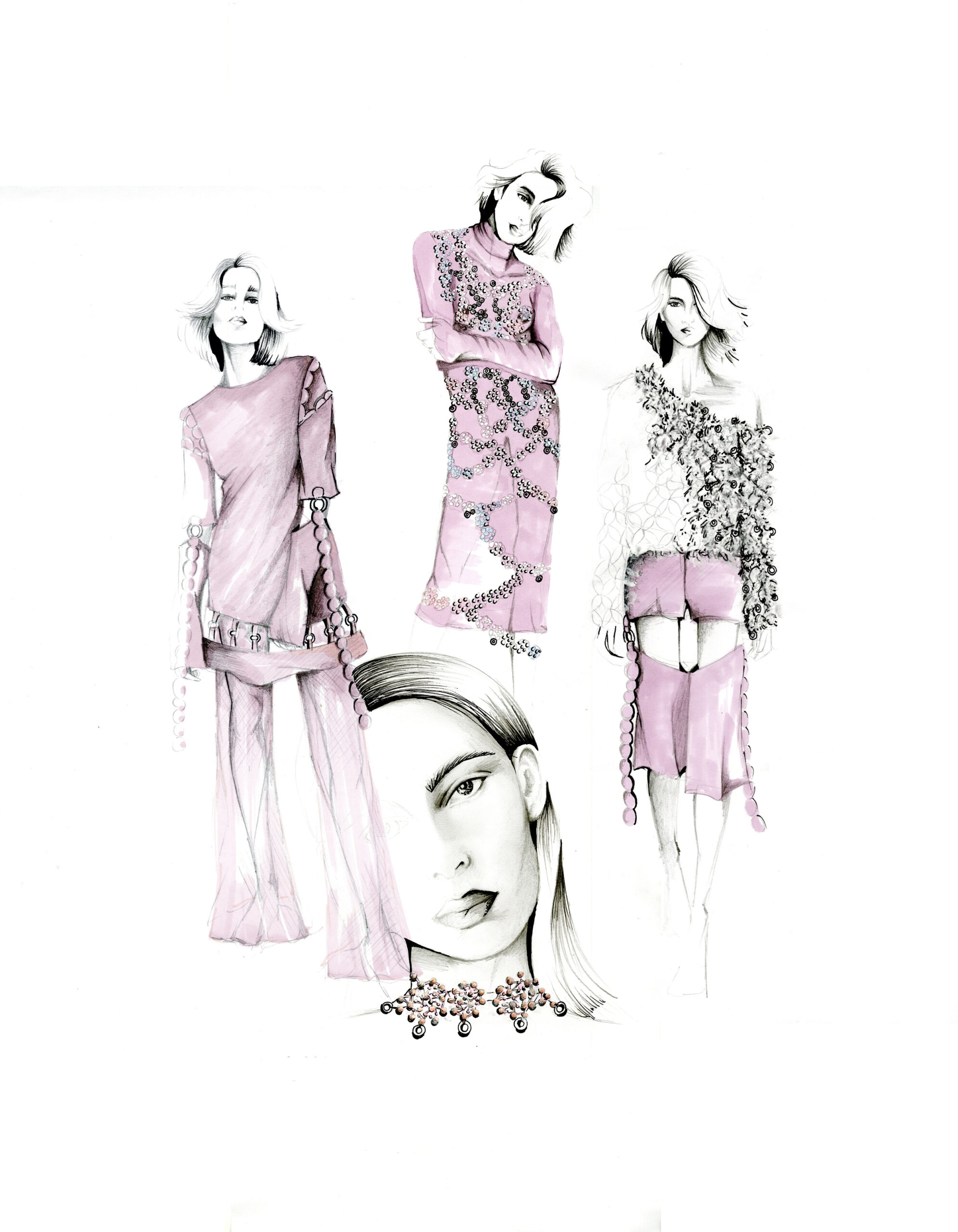[vc_row][vc_column][vc_row_inner][vc_column_inner width=”1/2″][vc_single_image image=”8516″ img_size=”large”][/vc_column_inner][vc_column_inner width=”1/2″][vc_single_image image=”8518″ img_size=”large” alignment=”center”][/vc_column_inner][/vc_row_inner][vc_column_text]Evoking the quietly devastating beauty of the wild, the designs of Polish born Ewa Polkowska take textural appliques, predawn hues, and organic silhouettes to create transformative garments so alive you can almost feel them breathing. Like a wind of mysterious origin, they’ve roused from the dormancy of millennia, hatchlings of the barren desert or the abyssal sediments of emerald green seas. They pulled the earth around them as they stood and took it as their traveling cloak. Wherever they came from, there is no escaping their connection to the terrestrial.[/vc_column_text][vc_column_text] The biggest surprise of Invisible World may come not from its air of mythos, but its derivation from microbiology. The tessellations, shapes, fabric, and colors are all operating on a level of connectedness happening just out of everyday sightline. Though her work may look like slices of a fantasy, they are made all the more fantastical by being based on science rather than legend. The resulting collection is clean, unique, and innovative while retaining an emboldened femininity. Fresh from debuting her collection at Copenhagen Fashion Week, Polkowska spoke with BASIC about the ins and outs of her erudite pieces, as well as her long-term plans for the future of design. [/vc_column_text][/vc_column][/vc_row][vc_row][vc_column][vc_row_inner][vc_column_inner][vc_single_image image=”8521″ img_size=”large”][/vc_column_inner][/vc_row_inner][vc_column_text]BASIC: Can you start by explaining where your collection derived its title?
I wanted to do a project for the future. And as I was looking for inspiration, I realized that there is this inner, tacit beauty around us that is maybe not visible to our eyes. The reason why I call my collection ‘Invisible World’- it’s named for what’s not frist seen.I collaborated with biotechnologists to understand how the world looks under a microscope. From what I saw, I created my textiles and the shape of my pieces. This is the innovative part – it’s something not typically visible, but just as beautiful as things readily seen. Invisible World is like a message – you can look for hidden things existing, their hidden potential.
BASIC: The shapes and colors of your pieces feel so light and organic, how were they conceived?
The shapes were taken primarily from sketches of orchids. I transformed them in different ways – for example, the sweater, the patterned jacket. I then decided to dig deeper and created the actual textiles. If you look at the dress with metal rings – it’s made from recycled plastic bottles. I collaborated with a company to make a special pattern, much like the world under a microscope with all the circles. The different sized molecules connected by rings reflect how not everything is regular under a microscope. You’ll see different sizes connected in different ways – there are open spaces and you can see transparency underneath. The colors were inspired by the Rob Kessler ‘Worlds Within’ exhibition in London, about revealing the patterns of plants on a very small scale. When you’re mixing plants under a microscope, everything is transparent. So if you want to get colors – it’s pretty cool actually – you see if you can create a new DNA of the plant. When there’s a reaction, the colors are created. Color change means something is happening. Based on these reactions, we dyed all the colors ourselves.
[/vc_column_text][/vc_column][/vc_row][vc_row][vc_column][vc_row_inner][vc_column_inner width=”1/2″][vc_single_image image=”8519″ img_size=”large”][/vc_column_inner][vc_column_inner width=”1/2″][vc_single_image image=”8522″ img_size=”large”][/vc_column_inner][/vc_row_inner][vc_column_text]BASIC: The theme of more-than-meets the eye goes even beyond the shapes beneath the microscopic. Can you tell us about the fabric primarily used in your collection?
I did the project using milk fiber. People drink milk everyday, but no one really thinks about how there could be an alternate use for it. Maybe we can create a fabric – from milk! The production of the fiber doesn’t use much water. It addresses waste, and along with using recycled plastic bottles, the collection takes on a sustainability aspect. People will look at these clothes and no one will see the invisible world – the world that we have under a microscope that actually is the innovation possible within the fashion industry.
[/vc_column_text][vc_column_text]BASIC: Why would you say that sustainability is especially important for the fashion world to adopt?
The designers are the most responsible ones for deciding what the customer is going to buy. If we are going to be making amazing clothes with new innovations – and we have the possibilities – it will be cool and people are going to buy it anyways. So they could be buying things that are sustainable. I think it’s the future, and it’s the message of my collection. It’s new, but it’s the responsible design. People are scared to say ‘sustainability.’ It’s too big. The industry isn’t going to change in a year; it’s not possible, especially financially. But I want to use my collection to show how nice milk fiber can look. A lot of people hear sustainability and think that it must be oversized, that it means baggy or not really feminine. And that’s not my collection at all. It’s tailored, it’s feminine, and a little bit sexy of course. But still, it’s sustainable – so it’s possible. It’s not just a collection. It’s better for the planet.
Order the Issue 6 HERE
[/vc_column_text][/vc_column][/vc_row][vc_row][vc_column][vc_separator][vc_column_text]
Designer Ewa Polkowska @ewapolkowska
Photography Aldona Kaczmarczyk
Editing Dominik Herman @retouchingeye
Makeup Martyna Nowak-Sadowska @nowaksadowska_makeup
Models Monika Mech @monicamech | Weronika Zebrowska @werozebrowska
Assistant Maciej Nimojewski | Zofia Kulig
Words by Amanda Vandenberg @amanda_mary_vandenberg
Graphic Design Brieona Cornelius @brieonacornelius
[/vc_column_text][/vc_column][/vc_row]
